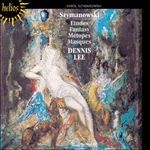Szymanowski’s Four Études, Op 4, were composed between 1900 and 1902. Before his Warsaw studies Szymanowski had attended the music school of his father’s cousin, Gustav Neuhaus, at Elisavetgrad, in what is now Ukraine. He dedicated these pieces to Tala (Natalia) Neuhaus, a lifelong friend. The harmonic and melodic inflections of early Scriabin are especially noticeable in the first Étude, in E flat minor, though not the distilled, evanescent brevity also characteristic of him. The second Étude, in G flat major, simultaneously divides groups of six semiquavers into subsets of both two and three to create an Escher-like, dizzying sense of conflicting perceptions. The B flat minor third Étude, which in posterity has achieved some independent fame, presents a sorrowful cantilena above slow repeating chords, rising to an imposing climactic restatement of the principal idea before reaching a sombre but subdued conclusion. The last Étude of the group offers a tantalizing glimpse of a far more tangential approach to tonality, juxtaposing hints of C major and A flat minor at the outset and launching without preamble into a restless discourse marked by obsessive repetition of short melodic motifs against a backdrop of triplet quavers. Eventually the fires burn themselves out, however, and with final calm comes unequivocal affirmation of C major as the sovereign key.
from notes by Francis Pott © 2014
Szymanowski composa les Quatre Études, op.4, entre 1900 et 1902. Avant ses études à Varsovie, Szymanowski était allé à l’école de musique du cousin de son père, Gustav Neuhaus, à Elisavetgrad, actuellement en Ukraine. Il dédia ses morceaux à Tala (Natalia) Neuhaus, avec laquelle il entretint une amitié toute sa vie durant. Les inflexions harmoniques et mélodiques du jeune Scriabine sont surtout perceptibles dans la première étude, en mi bémol mineur, mais pas la concision évanescente distillée également caractéristique de ce compositeur. La deuxième étude, en sol bémol majeur, divise simultanément des groupes de six doubles croches en sous-ensembles de deux et trois pour créer une impression vertigineuse de perception partagée à la Escher. La troisième étude en si bémol mineur, à laquelle la postérité a accordé isolément une certaine notoriété, est une cantilène triste sur de lents accords répétés qui avance vers une réexposition décisive et imposante de l’idée principale avant d’atteindre une conclusion sombre mais morose. La dernière étude du groupe offre un aperçu séduisant d’une approche beaucoup plus tangentielle de la tonalité, juxtaposant des soupçons d’ut majeur et de la bémol mineur au début et se lançant sans préambule dans un discours agité marqué par la répétition obsédante de courts motifs mélodiques sur fond de croches en triolets. Mais finalement le feu s’éteint de lui-même et, avec le calme final, c’est l’affirmation sans équivoque d’ut majeur comme tonalité souveraine.
extrait des notes rédigées par Francis Pott © 2014
Français: Marie-Stella Pâris
Szymanowskis Vier Etüden, op. 6, entstanden zwischen 1900 und 1902. Vor seinem Studium in Warschau hatte Szymanowski die Musikschule des Cousins seines Vaters, Gustav Neuhaus, in Jelisawetgrad (Kirowohrad) besucht, das in der heutigen Ukraine liegt. Tala (Natalia) Neuhaus, eine langjährige Freundin, war die Widmungsträgerin dieser Werke. Die harmonischen und melodischen Wendungen des frühen Skrjabin treten in der ersten Etüde es-Moll besonders deutlich hervor, jedoch nicht die konzentrierte, vergängliche Kürze, die ebenfalls charakteristisch für ihn ist. Die zweite Etüde steht in Ges-Dur und unterteilt Gruppen von sechs Sechzehnteln in Zweier- und Dreiergruppen, woraus sich ein Escher-artiger Eindruck geteilter Wahrnehmung einstellt. Die dritte Etüde in b-Moll, die später als eigenständiges Werk einen gewissen Ruhm erlangte, präsentiert eine trauervolle Kantilene über langsamen Akkordrepetitionen, die zu einer eindrucksvollen höhepunktartigen Wiederholung des Hauptmotivs aufsteigt, bevor ein düsterer, jedoch gedämpfter Abschluss erreicht wird. Die letzte Etüde in dieser Werkgruppe bietet einen verlockenden Einblick in einen deutlich sprunghafteren Umgang mit Tonalität, wo zu Beginn Anflüge von C-Dur und as-Moll einander gegenübergestellt werden und dann ohne weitere Einleitung ein ruheloser Diskurs eröffnet wird, der sich durch obsessive Wiederholungen kurzer melodischer Motive gegen einen Hintergrund von triolischen Achteln auszeichnet. Schließlich erlischt das Feuer jedoch und die Ruhe gegen Schluss stellt sich durch eine unmissverständliche Bestätigung von C-Dur als vorherrschende Tonart ein.
aus dem Begleittext von Francis Pott © 2014
Deutsch: Viola Scheffel


 PERFORMANCE
PERFORMANCE RECORDING
RECORDING
 PERFORMANCE
PERFORMANCE RECORDING
RECORDING Szymanowski: Piano Music
Szymanowski: Piano Music
